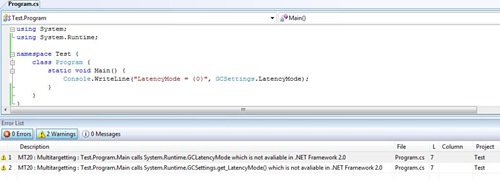In my new ongoing quest to read source code to be a better developer, I now present the seventh in an infinite number of a weekly series called "The Weekly Source Code." Here's some source I'm reading this week that I enjoyed.
I got a little sidetracked the recent trip to the ALT.NET conference, so forgive me for missing last week.
- Joe Cheng's Schwartzian Transform in C# 3.0 - Whenever someone knows the official name for technique, be it in chess or in code, they're usually smarter than I. "You are using Bonetti's Defense against me, ah?" Joe is one of those guys. ;)
"What’s a Schwartzian Transform? It’s a way of efficiently sorting a list of objects according to some potentially expensive-to-calculate property of those objects. For example, let’s say you have an array of filenames, and you want to sort them by their last modified dates"
This is a very useful technique to know and nice and clean in C# 3.0.
public static List<TElement> SortBy2<TElement, TSortBy>(
this List<TElement> coll,
Converter<TElement, TSortBy> converter,
Comparison<TSortBy> comparison)
{
return coll
.ConvertAll(el => new { Key = converter(el), Value = el })
.Sort((a, b) => comparison(a.Key, b.Key))
.ConvertAll(x => x.Value);
}
LINQ to Amazon - This is a little old, but it's still darn interesting to read. If you've been thinking about implementing LINQ over an object or web service that your company has, this is a good place to start. I'll let you go digging around, but here's some bits I found interesting. Note also that the code is very old and I haven't been able to find the latest stuff.
This is what I call Left-Hand/Right-Hand code where we're pulling with one hand, in this case XML and handing off with the other hand, in this case, making a LINQ List. It tends to be very tedious but LINQ sure makes it easy. XNamespace ns = NAMESPACE_AWSECommerceService;
var books = from book in booksDoc.Descendants(ns+"Item")
select new Book {
Title = book.Element(ns+"ItemAttributes").Element(ns+"Title").Value,
Publisher = book.Element(ns+"ItemAttributes").Element(ns+"Publisher").Value,
Year = uint.Parse(((String)book.Element(ns+"ItemAttributes").Element(ns+"PublicationDate").Value).Substring(0, 4)),
Authors = ( from author in book.Descendants(ns+"Author")
select (String) author.Value ).ToList()
};
Argotic Syndication Framework - Woof, a full implementation of Atom 1.0, OPML 2.0, RSD 1.0, and RSS 2.0 syndication formats. If you're looking for syndication source look no further. This is not only very clean code that's also well organized with a very interesting extension mechanism for including other namespaces within your syndication format. It's also excessively well documented. I hate them. ;) Although, I'm not sure where the tests are, it's pretty clear that this reflects a huge amount of work. Or a lot of code generation.
There is far too much to paste much here, but what are the things I click away was a new attribute but I hadn't heard of yet. You can tell FxCop to relax as they do here with a naming rule. [System.Diagnostics.CodeAnalysis.SuppressMessage("Microsoft.Naming", "CA1704:IdentifiersShouldBeSpelledCorrectly", MessageId = "Rss")]
public class RssFeedCreatedEventArgs : EventArgs, IComparable {...
LukeH and a fully LINQified RayTracer - Seriously, someone give this guy some money or a warm handshake or something. This is unreal...it's single line of LINQ. That means it's one expression. Luke is a glutton for punishment because I'm still trying to get my brain around the statement. This guy is a beast. I'm thinking of starting a cult around him. Here's his code, but go read his post for the explanation. Go! Right now! I'll wait here.
var pixelsQuery =
from y in Enumerable.Range(0, screenHeight)
let recenterY = -(y - (screenHeight / 2.0)) / (2.0 * screenHeight)
select from x in Enumerable.Range(0, screenWidth)
let recenterX = (x - (screenWidth / 2.0)) / (2.0 * screenWidth)
let point = Vector.Norm(Vector.Plus(scene.Camera.Forward, Vector.Plus(Vector.Times(recenterX, scene.Camera.Right),
Vector.Times(recenterY, scene.Camera.Up))))
let ray = new Ray { Start = scene.Camera.Pos, Dir = point }
let computeTraceRay = (Func<Func<TraceRayArgs, Color>, Func<TraceRayArgs, Color>>)
(f => traceRayArgs =>
(from isect in
from thing in traceRayArgs.Scene.Things
select thing.Intersect(traceRayArgs.Ray)
where isect != null
orderby isect.Dist
let d = isect.Ray.Dir
let pos = Vector.Plus(Vector.Times(isect.Dist, isect.Ray.Dir), isect.Ray.Start)
let normal = isect.Thing.Normal(pos)
let reflectDir = Vector.Minus(d, Vector.Times(2 * Vector.Dot(normal, d), normal))
let naturalColors = from light in traceRayArgs.Scene.Lights
let ldis = Vector.Minus(light.Pos, pos)
let livec = Vector.Norm(ldis)
let testRay = new Ray { Start = pos, Dir = livec }
let testIsects = from inter in
from thing in traceRayArgs.Scene.Things
select thing.Intersect(testRay)
where inter != null
orderby inter.Dist
select inter
let testIsect = testIsects.FirstOrDefault()
let neatIsect = testIsect == null ? 0 : testIsect.Dist
let isInShadow = !((neatIsect > Vector.Mag(ldis)) || (neatIsect == 0))
where !isInShadow
let illum = Vector.Dot(livec, normal)
let lcolor = illum > 0 ? Color.Times(illum, light.Color) : Color.Make(0, 0, 0)
let specular = Vector.Dot(livec, Vector.Norm(reflectDir))
let scolor = specular > 0
? Color.Times(Math.Pow(specular, isect.Thing.Surface.Roughness), light.Color)
: Color.Make(0, 0, 0)
select Color.Plus(Color.Times(isect.Thing.Surface.Diffuse(pos), lcolor),
Color.Times(isect.Thing.Surface.Specular(pos), scolor))
let reflectPos = Vector.Plus(pos, Vector.Times(.001, reflectDir))
let reflectColor = traceRayArgs.Depth >= MaxDepth
? Color.Make(.5, .5, .5)
: Color.Times(isect.Thing.Surface.Reflect(reflectPos),
f(new TraceRayArgs(new Ray { Start = reflectPos, Dir = reflectDir },
traceRayArgs.Scene, traceRayArgs.Depth + 1)))
select naturalColors.Aggregate(reflectColor, (color, natColor) => Color.Plus(color, natColor))) .DefaultIfEmpty(Color.Background).First())
let traceRay = Y(computeTraceRay)
select new { X = x, Y = y, Color = traceRay(new TraceRayArgs(ray, scene, 0)) };
foreach (var row in pixelsQuery)
foreach (var pixel in row)
setPixel(pixel.X, pixel.Y, pixel.Color.ToDrawingColor());
Feel free to send me links to cool source that you find hasn't been given a good read.
Hosting By











 My
My 
